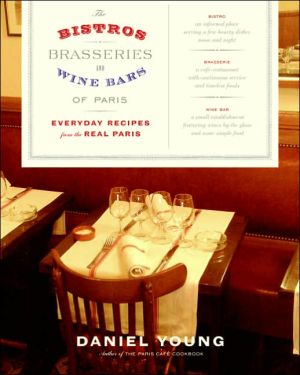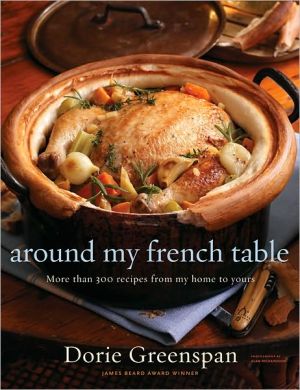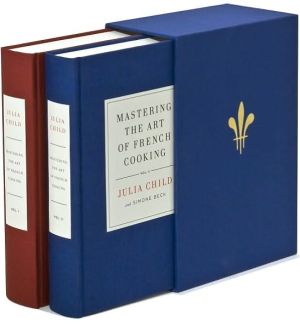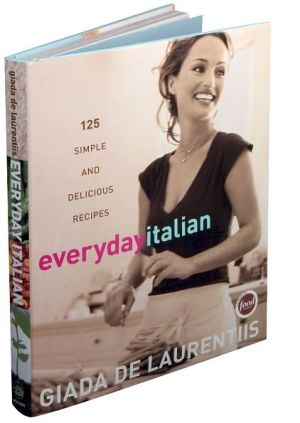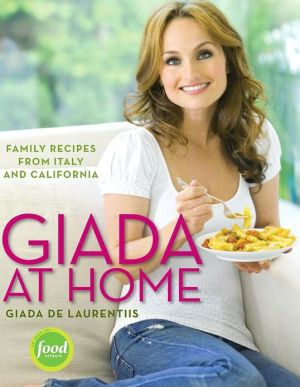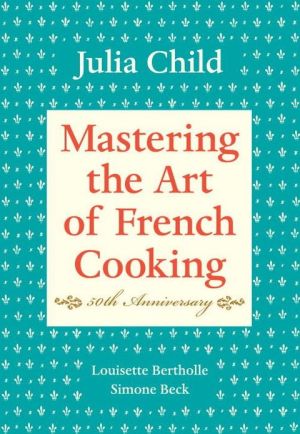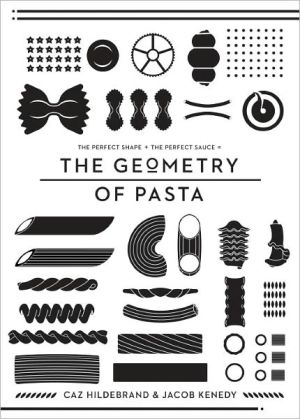Bistros, Brasseries, and Wine Bars of Paris: Everyday Recipes from the Real Paris
You can spend years in Paris and never hear the same answer twice to this cookbook's underlying question: what is the difference between a bistro, a brasserie, and a wine bar? In his third cookbook, acclaimed author and expert on all things French Daniel Young explains the nuances between the three, as he takes home cooks on a vibrant, spirited tour of Paris's best eateries.\ Daniel explains that, as true Parisians know; a bistro is a small, informal restaurant serving a few simple, hearty...
Search in google:
You can spend years in Paris and never hear the same answer twice to this cookbook's underlying question: what is the difference between a bistro, a brasserie, and a wine bar? In his third cookbook, acclaimed author and expert on all things French Daniel Young explains the nuances between the three, as he takes home cooks on a vibrant, spirited tour of Paris's best eateries. Daniel explains that, as true Parisians know; a bistro is a small, informal restaurant serving a few simple, hearty dishes, while a brasserie is a larger, cafe–restaurant providing continuous service and rough–and–ready food. In a wine bar, expect to find a large selection of wines by the glass and light bites to go with them. Daniel also introduces home cooks to many of his favorite spots (some are famous, others are his own best–keep secrets) and presents classic recipes from each, including Salmon Terrine with Leeks and Pesto, Cream of Carrot Soup with Cumin, Pan–Grilled Rib Steak with Béarnaise Sauce, and Warm Almond Cake with Caramel Cream. Bistros, brasseries, and wine bars, define what it means to be out and eat out in Paris, to dine simply and very well. Theirs is the food that nourishes and sustains the Paris of Parisians – the real and everyday Paris – with local flavor, style, sophistication, personality, and attitude. Publishers Weekly The premise of this savvy, stylish cookbook is that French chefs can teach us a thing or two about fast food. Young (The Paris Caf Cookbook) trains his investigative palate on Paris's sophisticated but informal eateries: wine bars, bistros and brasseries. In his well-researched introduction, he distinguishes the three types of establishments, offering a short history of each (all three, it happens, have evolved in a similar direction, so that classifications like "gastro bistro" and "brasserie du luxe" are less descriptive than they used to be). Cooking in such places elevates local, seasonal and often cheap ingredients into inventive concoctions, like a chicken roasted with crushed hazelnuts and cauliflower florets, or Nectarine Gratin with Mango Coulis. Many of the recipes are simply classic: Cheese Puffs (Gougeres), Warm Lentil Salad, Onion Soup Gratinee, Pan-Grilled Rib Steak with Bearnaise Sauce, Choucroute and Chocolate Profiteroles. For a somewhat experienced chef with a willful disregard for cholesterol, these are easy to make at home. For the more casual cookbook browser, Young has also included a dining guide of the essential bistros, brasseries and wine bars he so temptingly describes. B&w photos. (Feb.) Copyright 2005 Reed Business Information.
The Bistros, Brasseries, and Wine Bars of Paris\ Everyday Recipes from the Real Paris \ \ By Daniel Young \ HarperCollins Publishers, Inc.\ Copyright © 2006 Daniel Young\ All right reserved. \ ISBN: 0060590734 \ \ \ Le Beurre Noisette\ Celery Root Puree\ Puree de Celeri-rave \ Makes 3 to 6 side-dish servings\ \ Served at Le Beurre Noisette as an accompaniment to the bistro's rosemary veal roast (page 111), this celery root puree complements any number of meat, poultry, and fish dishes. For optimum creaminess, Thierry Blanqui uses rice as the starch in his puree, not potatoes, the dish's customary thickening agent. The water contained in the potatoes can dilute the puree's texture as well as its mild taste. The only risk in preparing it Blanqui's way is that the silky smooth puree becomes a distraction. You just can't keep your fork away from it. A quantity that should feed up to six people easily gets polished off by three.\ Ingredients:\ 1 celery root (about 1 1/2 pounds), peeled, trimmed, and cut into 1-inch cubes\ 1 quart whole milk\ Coarse sea salt\ 2 tablespoons long-grain white rice\ 3/4 cup heavy cream\ Instructions:\ Place the celery root in a saucepan, cover with the milk, season with a pinch of salt, and heat over medium-high heat to a boil. Add the rice, lower the heat to low, partially cover, and simmer, stirring occasionally, until very soft, 40 to 45 minutes.\ Drain the celery and rice, reserving the liquid (which, once cooled, can be frozen and later served as a soup), transfer to a blender or food processor and puree, scraping down the sides as necessary, until smooth.\ Place the cream in a saucepan over medium heat and heat just to a boil, stirring with a wooden spoon to keep it from boiling over. Reduce the heat to low and simmer until the cream is slightly reduced and thickened, about 3 minutes. Add the pureed celery root and rice and cook, stirring constantly, until all the moisture has been absorbed, 2 to 3 minutes. Remove from the heat, season with salt, whip with a whisk to fluff the puree, and serve.\ \ Le Bistrot Des Capucins\ House-Salted Cod Wrapped in Ham\ Morue en Jambon\ Serves 4\ \ Frustrated by the bother and uncertainty of soaking, desalting, and rehydrating dried salt cod in several changes of water over many hours, chefs like Gerard Fouche have taken to salting their own fresh cod. It allows them to have better control over the quality of the fish and the quantity of the salt. Overnight salting gives fresh cod a firmer texture that holds together better when wrapped with ham. Fouche suggests serving the ham-wrapped house-salted cod fillets over eggs piperade (page 139).\ Ingredients:\ 4 skinless codfish fillets, 6 to 7 ounces each\ 2 tablespoons coarse sea salt\ 1/4 to 1/2 teaspoon piment d'Espelette or ancho powder or other medium-hot chili powder\ 3 tablespoons olive oil\ 4 thin slices country ham\ Instructions:\ The day before you plan to serve: Season the cod fillets on both sides with salt and piment d'Espelette. Place a couple of small plates upside down over a serving plate or tray, lay the fillets over the plates (this will allow the liquid to drain off), cover with plastic wrap, and refrigerate overnight.\ Preheat the oven to 400°F. Heat the olive oil in a skillet over medium heat. Add the salted cod fillets and cook just until lightly golden, about 1 minute on each side. Drain on paper towels.\ Working with one slice at a time, spread out the ham, lay a cod fillet over the ham, and roll it, tucking the end of the ham under itself to hold it in place, and transfer to a baking pan. Repeat with the remaining fillets. Place in the oven and bake until just cooked through, 6 to 8 minutes, depending on the thickness of the fillets. Serve atop eggs piperade, potatoes, or rice.\ Continues...\ \ \ \ Excerpted from The Bistros, Brasseries, and Wine Bars of Paris by Daniel Young Copyright © 2006 by Daniel Young. Excerpted by permission.\ All rights reserved. No part of this excerpt may be reproduced or reprinted without permission in writing from the publisher.\ Excerpts are provided by Dial-A-Book Inc. solely for the personal use of visitors to this web site. \ \
\ Publishers WeeklyThe premise of this savvy, stylish cookbook is that French chefs can teach us a thing or two about fast food. Young (The Paris Caf Cookbook) trains his investigative palate on Paris's sophisticated but informal eateries: wine bars, bistros and brasseries. In his well-researched introduction, he distinguishes the three types of establishments, offering a short history of each (all three, it happens, have evolved in a similar direction, so that classifications like "gastro bistro" and "brasserie du luxe" are less descriptive than they used to be). Cooking in such places elevates local, seasonal and often cheap ingredients into inventive concoctions, like a chicken roasted with crushed hazelnuts and cauliflower florets, or Nectarine Gratin with Mango Coulis. Many of the recipes are simply classic: Cheese Puffs (Gougeres), Warm Lentil Salad, Onion Soup Gratinee, Pan-Grilled Rib Steak with Bearnaise Sauce, Choucroute and Chocolate Profiteroles. For a somewhat experienced chef with a willful disregard for cholesterol, these are easy to make at home. For the more casual cookbook browser, Young has also included a dining guide of the essential bistros, brasseries and wine bars he so temptingly describes. B&w photos. (Feb.) Copyright 2005 Reed Business Information.\ \ \ \ \ Library JournalFrancophiles and food lovers will all enjoy Young's (The Paris Caf Cookbook) compendium of classic bistro, brasserie, and wine bar fare like Poached Skate Wing with Brown Butter Sauce and new favorites like Willi's Wine Bar Mix, which can easily be made by any North American cook. From appetizers to main courses and desserts, the book features something for every cook, no matter what her or his comfort level in the kitchen. Readers are also offered an examination of the differences among the three titular establishments and a directory for each, which will especially interest those wanting to learn more about these typically Parisian places. Young, who worked as the restaurant critic for the New York Daily News, spends part of the year in Paris, and his knowledge of the city certainly comes through. A useful and enjoyable addition to public libraries.-Shelley Brown, Richmond P.L., Vancouver, B.C. Copyright 2006 Reed Business Information.\ \
